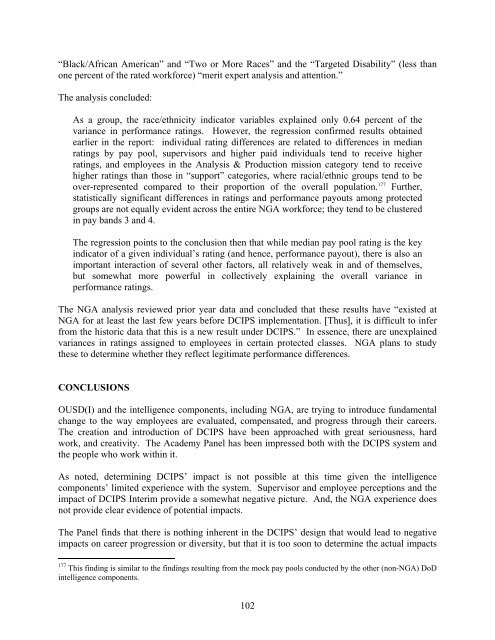Report - Government Executive
Report - Government Executive
Report - Government Executive
You also want an ePaper? Increase the reach of your titles
YUMPU automatically turns print PDFs into web optimized ePapers that Google loves.
“Black/African American” and “Two or More Races” and the “Targeted Disability” (less than<br />
one percent of the rated workforce) “merit expert analysis and attention.”<br />
The analysis concluded:<br />
As a group, the race/ethnicity indicator variables explained only 0.64 percent of the<br />
variance in performance ratings. However, the regression confirmed results obtained<br />
earlier in the report: individual rating differences are related to differences in median<br />
ratings by pay pool, supervisors and higher paid individuals tend to receive higher<br />
ratings, and employees in the Analysis & Production mission category tend to receive<br />
higher ratings than those in “support” categories, where racial/ethnic groups tend to be<br />
over-represented compared to their proportion of the overall population. 177 Further,<br />
statistically significant differences in ratings and performance payouts among protected<br />
groups are not equally evident across the entire NGA workforce; they tend to be clustered<br />
in pay bands 3 and 4.<br />
The regression points to the conclusion then that while median pay pool rating is the key<br />
indicator of a given individual’s rating (and hence, performance payout), there is also an<br />
important interaction of several other factors, all relatively weak in and of themselves,<br />
but somewhat more powerful in collectively explaining the overall variance in<br />
performance ratings.<br />
The NGA analysis reviewed prior year data and concluded that these results have “existed at<br />
NGA for at least the last few years before DCIPS implementation. [Thus], it is difficult to infer<br />
from the historic data that this is a new result under DCIPS.” In essence, there are unexplained<br />
variances in ratings assigned to employees in certain protected classes. NGA plans to study<br />
these to determine whether they reflect legitimate performance differences.<br />
CONCLUSIONS<br />
OUSD(I) and the intelligence components, including NGA, are trying to introduce fundamental<br />
change to the way employees are evaluated, compensated, and progress through their careers.<br />
The creation and introduction of DCIPS have been approached with great seriousness, hard<br />
work, and creativity. The Academy Panel has been impressed both with the DCIPS system and<br />
the people who work within it.<br />
As noted, determining DCIPS’ impact is not possible at this time given the intelligence<br />
components’ limited experience with the system. Supervisor and employee perceptions and the<br />
impact of DCIPS Interim provide a somewhat negative picture. And, the NGA experience does<br />
not provide clear evidence of potential impacts.<br />
The Panel finds that there is nothing inherent in the DCIPS’ design that would lead to negative<br />
impacts on career progression or diversity, but that it is too soon to determine the actual impacts<br />
177 This finding is similar to the findings resulting from the mock pay pools conducted by the other (non-NGA) DoD<br />
intelligence components.<br />
102













